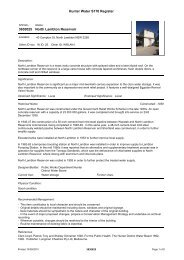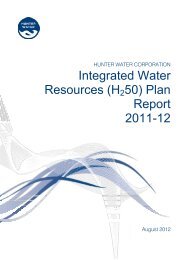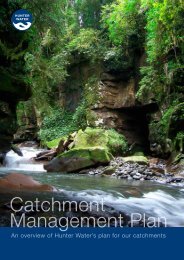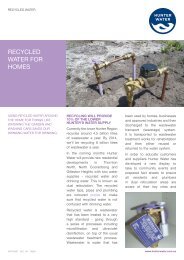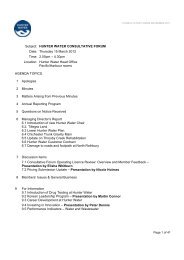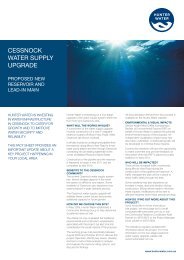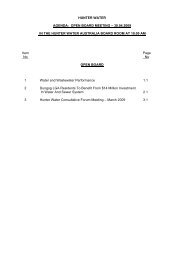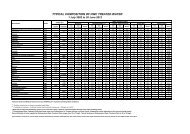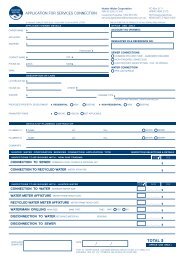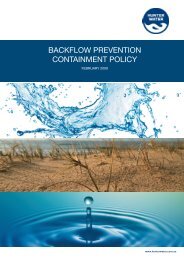Water Kit - Hunter Water
Water Kit - Hunter Water
Water Kit - Hunter Water
You also want an ePaper? Increase the reach of your titles
YUMPU automatically turns print PDFs into web optimized ePapers that Google loves.
<strong>Water</strong> From The Mountains<br />
Chichester Dam holds 21,500ML(one<br />
megalitre (ML) is one million litres).<br />
The catchment covers 120km2.<br />
The wall is constructed from<br />
thousands of inter-locking units of<br />
concrete. The 1000mm pipe to<br />
Newcastle is 85km long. After<br />
completion investigations began on<br />
a third source with a view to closing<br />
the Walka <strong>Water</strong> Works, the likely<br />
choice being the Tomago Sandbeds.<br />
More <strong>Water</strong> From<br />
Underground<br />
The Tomago Sandbeds stretch 25km<br />
from Tomago to Port Stephens and are<br />
4km wide. The total catchment<br />
area is 105km2. Sand deposits<br />
underground hold freshwater ranging<br />
from 7m above to 15m below sea<br />
level. <strong>Hunter</strong> <strong>Water</strong> extracts up to<br />
16,500 ML per year of raw water<br />
through a system of bores and pump<br />
stations. Extracted water is treated at<br />
the Tomago Treatment Plant.<br />
Production and Consumption<br />
Through the 1950s the <strong>Hunter</strong> kept<br />
growing as a major commercial centre<br />
for coal, steel, manufacturing and<br />
agriculture - serviced by the port of<br />
Newcastle. Growth in water use was<br />
linked to industrial activity; between1939<br />
and 1952 the population suppliedwith<br />
water rose 10% but waterconsumption<br />
jumped by 90%. Demand again placed<br />
pressure on available supply.<br />
1925 1940<br />
1955<br />
Depression and Then<br />
Recovery<br />
The Walka <strong>Water</strong> Works were closed<br />
in 1931 due to the Great Depression<br />
By 1935 the economy had recovered<br />
and in 1936 work began on the<br />
Tomago Sandbeds. The <strong>Water</strong> Board<br />
played a crucial role during World<br />
War II during which time consumption<br />
grew 50%. As a result, the Tomago<br />
Sandbeds changed from a backup<br />
water source to an indispensable<br />
part of the water system.<br />
1937<br />
<strong>Water</strong> kit . ssS . 001 . april 2010<br />
9




